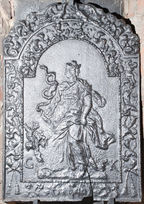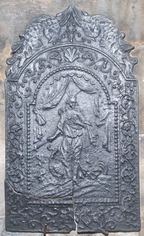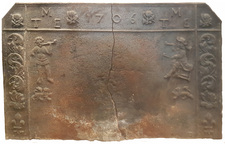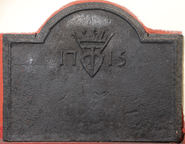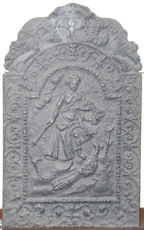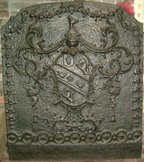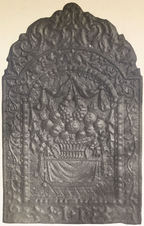-
344
Description: Arched rectangular central panel, with bead-and-pellet edging; pictorial, standing female figure in classical dress, facing to the left, holding a snake in her right hand, a bunch of flowers at lower left; the initials located in bottom corners; arched rectangular border, fillet edging, containing swirled foliage, with a putto in the top corners; on top, two perched bird facing each other, with swirled foliage descending behind them.
Notes: The figure is of Sapientia, or Wisdom, based closely on an engraving, one of a set entitled 'The Virtues' by Hendrik Goltzius c.1593; a small number of firebacks bear the initials, GK; it is not known to whom they refer, but dated ones are of 1700.
Copies of this fireback are known.
Inscription: G K
- Decoration tags:
- 'Dutch' (shape)
- fillet (edging)
- whole carved pattern
- pictorial
- allegorical
- text
- humans
Manufactured: in the early-18th century in the Siegerland area of Germany.
Current location: Ightham Mote, Ightham, Kent, England.
Museum number: 825381 (part of the National Trust museum group)
- Attached to series:
- 'Dutch' GK series
-
346
Description: Rectangular with arched rectangular shaped top joined by cavetto curves; astragal edging; shield, supporters, ducal coronet, motto and garter of the Duke of Dorset: Quarterly, Or and gules, a bend vair.
Notes: Almost certainly the arms of Lionel Sackville KG (1688-1765), created first duke of Dorset in 1720.
Copies of this fireback are known.
Inscription: [around shield] HONY SOIT QUI MAL Y PENSE / [on motto scroll] AUT NUNQUAM TENTES, AUT PERFICE
Arms: Lionel Sackville, 1st Duke of Dorset
- Decoration tags:
- rectangular with canted top corners and round arch (shape)
- astragal (edging)
- carved pattern panels
- text
Manufactured: in the early-18th century in the Weald area of England.
Current location: Ightham Mote, Ightham, Kent, England.
Museum number: 825513 (part of the National Trust museum group)
- Attached to series:
- Dorset arms series
- Personal armorial firebacks
- Sackville firebacks
-
358
Description: Arched rectangular central panel with bead edging on a broad fillet; standing on a ground with a peacock behind her, a classically-dressed figure of a female, wearing a crown and holding a sceptre in her right hand, her left hand across her chest; above her, swagged drapery; arched rectangular border with fillet edging; central scallop shell at the top with a descending arrangement of swirled and interlinked lines; at bottom centre, a cartouche bearing the letter ‘N’; on top, two mirrored serpents.
Notes: The figure is that of Hera/Juno. The pattern maker identified as ‘N’ is likely to have been working in collaboration with pattern makers whose fireback designs are identified with the initials, SHR and EB, and with the maker responsible for patterns made in 1724, some of which bore inscriptions in Welsh.
Inscription: N
- Decoration tags:
- 'Dutch' (shape)
- fillet (edging)
- whole carved pattern
- pictorial
- mythological
- text
- animals
- humans
Manufactured: in the early-18th century in England.
Current location: Baddesley Clinton Hall, Knowle, Warwickshire, England.
Museum number: 342886 (part of the National Trust museum group)
- Attached to series:
- N series
- British 'Dutch' style firebacks
-
841
Description: Canted rectangle; cavetto-moulded edging (top and sides); single horizontal fillet below canted corners and vertical fillet parallel to each side, dividing the fireback into two side panels, two top corner panels, top panel and main central panel; corner panels, ‘daisy’ plant stamp; top panel, date between ‘daisy’ stamps, between initials in triad at each end; side panels, swirling foliage stamp repeated each side above a fleur-de-lys; centre panel, stamp of ‘Indian’ smoking a pipe at top left, stamp of seated ‘gentleman’ smoking a pipe and holding another, at top right; below each, a lion passant stamp, facing right on the left and facing left on the right; initials IB in bottom corners of centre panel.
Notes: The 'daisy' stamp is identical to those on similar firebacks dated between 1703 and 1721, and probably indicating the same founder whose initials IB are at the bottom; the use of stamps relating to tobacco smoking may suggest an origin near Bristol, the main entry port for the tobacco trade at that time. Previously noted at Little Faringdon House, near Lechlade. Bishop & Miller auction, Stowmarket, Suffolk, 25 May 2022, lot 293 (ns).
Inscription: TME [triad] 1706 TME [triad] / I B
- Decoration tags:
- rectangular with canted top corners (shape)
- cavetto (edging)
- carved stamps
- individual letters
- individual numbers
- heraldic
- text
- animals
- humans
- plants
- objects
Manufactured: in 1706 in the Forest of Dean area of England.
Current location: not known.
- Attached to series:
- IB series
- Fleur-de-lys firebacks
-
389
Description: Arched rectangular shape; plain edge with inset astragal on all sides; stylised buckle surmounted by an earl’s coronet between the two halves of the date.
Notes: The buckle is the badge of the Pelham family and the earl’s coronet may refer to the Earldom of Clare to which Thomas Pelham-Holles, 2nd Baron Pelham of Laughton was raised in 1714. The following year he was created Marquess of Clare and Duke of Newcastle-upon-Tyne. Formerly part of the J. H. Every collection.
Inscription: 17 15
- Decoration tags:
- rectangular with round arch (shape)
- flanged (edging)
- carved stamps
- individual numbers
- heraldic
- text
Manufactured: in 1715 in the Weald area of England.
Current location: Anne of Cleves House, Southover High Street, Lewes, East Sussex, England.
Museum number: 1944.24.084 (part of the Sussex Archaeological Society museum group)
- Attached to series:
- Pelham family firebacks
-
415
Description: Arched rectangular central panel with bead-and-pellet edging on a broad fillet; figure of Hera/Juno, a sceptre in her right hand, with a peacock below to her left, clouds above left; arched rectangular border with fillet edging; symmetrical arrangement of wire-work swirls; on top, two mirrored serpents.
Notes: Similarities in the design and execution of the pattern suggest the work of the pattern-maker identified as ‘N’. Said to have been cast by Thomas Prickett (1727-95) at Gloucester Furnace, Lamberhurst.
Copies of this fireback are known.
- Decoration tags:
- 'Dutch' (shape)
- fillet (edging)
- whole carved pattern
- pictorial
- mythological
- animals
- humans
Manufactured: in the early-18th century probably at Gloucester Furnace, Lamberhurst in the Weald area of England.
Current location: Anne of Cleves House, Southover High Street, Lewes, East Sussex, England.
Museum number: LH000.948 (part of the Sussex Archaeological Society museum group)
Citation: Dawson, C., 1903, 'Sussex Iron Work and Pottery', Sussex Archaeological Collections, 46, pp. 1-54.
- Attached to series:
- British 'Dutch' style firebacks
-
417
Description: Rectangular central panel with top arch, bead edging; pictorial scene of a a kneeling man in a wide-brimmed hat reaching up the skirt of a milk maid, who in fending him off, leans forward, tipping the milk from the bucket on her head over the man; acanthus leaves over the top arch; side border with bead edging extending over shoulders of plate, surmounted by a floral vase each side; on top a floral vase between leaves.
Notes: Inscription on the back of the casting: 'Made from a casting lent to J. H. E[very] by Mr J. T. Ade of Hellingly'.
Copies of this fireback are known.
- Decoration tags:
- 'Dutch' (shape)
- bead (edging)
- whole carved pattern
- pictorial
- humans
Manufactured: in the early-18th century in England.
Current location: Anne of Cleves House, Southover High Street, Lewes, East Sussex, England.
Museum number: 1944.24.081 (part of the Sussex Archaeological Society museum group)
Citation: Lloyd, N., 1925, 'Domestic Ironwork I', Architectural Review, 58, pp. 58-67.
- Attached to series:
- Miscellaneous pattern firebacks
-
418
Description: Cavetto-arched rectangular central panel with bead-and-pellet edging, head and robed shoulders of a laureated man in left profile; cavetto-arched rectangular border with cavetto-moulded edging and arrangement of outward-facing acanthus leaves; on top, scallops on shoulders of border with cornucopiae over arch.
Notes: A pastiche of the 'Dutch' style of fireback. Formerly part of the J. H. Every collection.
- Decoration tags:
- 'Dutch' (shape)
- bead-and-pellett (edging)
- whole carved pattern
- pictorial
- humans
Manufactured: in the early-18th century in England.
Current location: Anne of Cleves House, Southover High Street, Lewes, East Sussex, England.
Museum number: 1944.24.090 (part of the Sussex Archaeological Society museum group)
- Attached to series:
- Miscellaneous pattern firebacks
-
428
Description: Rectangular, with low curved top and stepped concave corners; suspended floral-chain border on top and sides; alternate small and large rings along the bottom; plain panel at base. Arms of Webster, baronet, of Battle: Azure, on a bend argent, cotised Or, between two demi-lions ermine, a rose gules, barbed and seeded proper, between two boars’ heads couped sable.
Notes: Sir Thomas Webster was created baronet in 1703; he was succeeded by his son, Whistler, in 1750. A pair of matching, cast-iron side plates form a set with this fireback.
Copies of this fireback are known.
Arms: Webster of Battle
- Decoration tags:
- rectangular with canted top corners and round arch (shape)
- none (edging)
- whole carved pattern
- armorial
Manufactured: in the early-18th century possibly at Robertsbridge Furnace, Salehurst in the Weald area of England.
Current location: Barbican House, High Street, Lewes, East Sussex, England.
Museum number: 39.52/LH000.986 (part of the Sussex Archaeological Society museum group)
- Attached to series:
- Personal armorial firebacks
-
1049
Description: Arched rectangular central panel with alternate two-bead and pellet edging; table with draped cloth surmounted by a basket containing fruit, swagged drapery above; arched rectangular border with fillet edging; descending vine with leaves and berries; bottom centre, initials separated by a lozenge; on top, symmetrical swirled foliage.
Notes: Typical pastiche of the 'Dutch' style of fireback produced with the option to affix it to a basket grate. The basket of fruit was probably inspired by still-life paintings by European artists of the first half of the 17th century. Formerly part of the J. H. Every collection.
Inscription: I T
Manufactured: in the early-18th century in England.
Current location: Anne of Cleves House, Southover High Street, Lewes, East Sussex, England.
Museum number: 1944.24.082 (part of the Sussex Archaeological Society museum group)
- Attached to series:
- British 'Dutch' style firebacks
- Fruit basket firebacks
